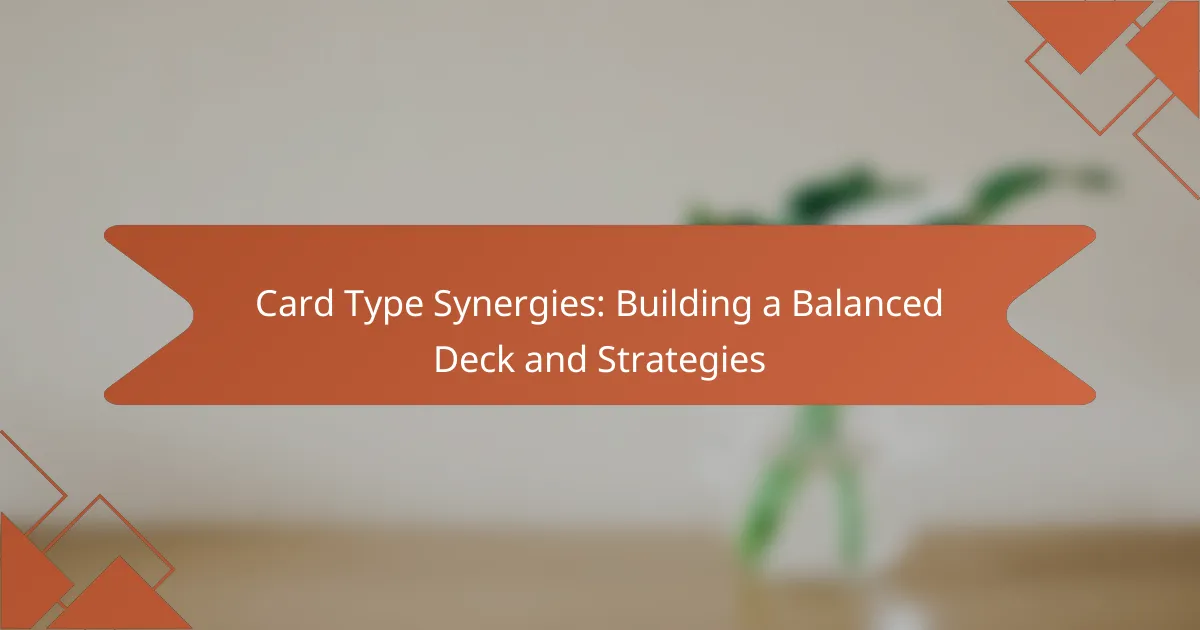Building a balanced deck through card type synergies is essential for enhancing gameplay performance. By selecting cards that complement each other, players can create powerful combinations that leverage strengths and mitigate weaknesses. Understanding these interactions allows for the development of cohesive strategies that can lead to more competitive and effective decks.

How to build a balanced deck using card type synergies?
Building a balanced deck using card type synergies involves selecting cards that work well together to enhance overall performance. Focus on creating combinations that maximize strengths while minimizing weaknesses, ensuring a cohesive strategy throughout the game.
Identify complementary card types
Start by analyzing the card types in your collection. Look for synergies between creature, spell, and artifact types that can enhance your gameplay. For instance, pairing aggressive creatures with spells that boost their attack can create a formidable offensive strategy.
Consider the roles of each card type. Creatures can serve as blockers or attackers, while spells can provide removal or support. Aim for a mix that allows you to adapt to various situations during gameplay.
Incorporate synergy-focused strategies
Develop strategies that leverage the strengths of your chosen card types. For example, if you have a lot of creature cards, consider strategies that involve swarm tactics or buffing your creatures for a stronger board presence. This can overwhelm opponents and create pressure.
Utilize cards that enhance your primary strategy. If your deck focuses on spells, include cards that allow you to draw more spells or reduce their casting costs. This creates a feedback loop that can keep your hand full and your options open.
Utilize mana curve for balance
A balanced mana curve is essential for maintaining a steady flow of plays throughout the game. Aim for a mix of low, mid, and high-cost cards to ensure you can play something each turn. A typical curve might include around 40% low-cost cards, 40% mid-cost, and 20% high-cost.
Pay attention to the distribution of mana costs. If your deck has too many high-cost cards, you may find yourself unable to play effectively in the early game. Conversely, too many low-cost cards can leave you without impactful plays later on.
Test and refine deck composition
Regularly playtest your deck to identify strengths and weaknesses. Pay attention to how often you draw the cards you need and whether your strategies are effective against various opponents. This feedback is crucial for making informed adjustments.
After testing, refine your deck by swapping out underperforming cards for alternatives that better fit your strategy. Consider the overall balance of card types and mana costs to ensure your deck remains cohesive and competitive.

What are effective strategies for card type synergy?
Effective strategies for card type synergy involve creating a cohesive deck that maximizes the strengths of different card types, ensuring they work together to enhance overall performance. By focusing on archetype strengths, leveraging creature and spell interactions, and implementing appropriate strategies, players can build a balanced and competitive deck.
Focus on archetype strengths
Understanding the strengths of various archetypes is crucial for building a synergistic deck. Each archetype, such as aggro, control, or midrange, has unique characteristics that dictate how cards should interact. For instance, an aggro deck thrives on quick, aggressive plays, while a control deck focuses on managing the game and outlasting opponents.
To capitalize on archetype strengths, select cards that complement your chosen strategy. For example, in an aggro deck, prioritize low-cost creatures and direct damage spells to maintain pressure. Conversely, in a control deck, include counterspells and card draw to maintain control over the game.
Leverage synergy between creatures and spells
Creating synergy between creatures and spells enhances the effectiveness of your deck. Certain spells can boost the power of your creatures or provide additional benefits when specific conditions are met. For example, spells that grant buffs to creatures can turn a modest creature into a formidable threat.
Consider including spells that trigger effects when creatures enter or leave the battlefield. This can create powerful combinations, such as using a spell that draws cards when a creature dies, allowing you to maintain card advantage while controlling the board.
Implement control versus aggro strategies
Choosing between control and aggro strategies is essential for deck synergy. Control strategies focus on managing the game, using removal spells and counterspells to disrupt opponents while building towards a late-game win condition. In contrast, aggro strategies prioritize fast, aggressive plays to overwhelm opponents before they can establish their game plan.
When implementing these strategies, consider the balance of your deck. A control deck may benefit from a higher ratio of spells to creatures, while an aggro deck should lean towards more creatures and direct damage spells. Regularly assess your deck’s performance and adjust the balance to ensure it aligns with your chosen strategy.

Which card types offer the best synergies in popular games?
In popular card games, certain types of cards work exceptionally well together, enhancing overall strategy and effectiveness. Understanding these synergies can significantly improve deck performance and gameplay outcomes.
Creature and enchantment synergies in Magic: The Gathering
In Magic: The Gathering, creature and enchantment synergies are pivotal for creating powerful combinations. Enchantments can enhance creatures by providing boosts to their stats or granting special abilities, such as flying or trample. For example, cards like “Ethereal Absolution” can strengthen all your creatures while weakening opponents’ creatures, leading to a significant advantage.
When building a deck, consider including enchantments that complement your creature types. Look for cards that trigger effects when creatures enter the battlefield or when they attack. This approach can create a formidable board presence and pressure your opponent effectively.
Artifact and creature combinations in Yu-Gi-Oh!
In Yu-Gi-Oh!, combining artifacts with creatures can lead to devastating strategies. Artifacts often provide unique effects that can enhance the abilities of your monsters or protect them from destruction. For instance, cards like “Mystical Space Typhoon” can clear the field of threats, allowing your creatures to attack freely.
To maximize these synergies, focus on building a deck that includes both high-impact creatures and versatile artifacts. Ensure that your artifacts can be easily summoned or activated to maintain momentum during the game. This balance can create a dynamic and resilient deck.
Spell and creature interactions in Hearthstone
In Hearthstone, the interaction between spells and creatures is crucial for effective gameplay. Spells can deal damage, heal, or provide buffs to your minions, creating opportunities for powerful plays. For example, using a spell like “Blessing of Kings” can turn a low-cost creature into a formidable threat on the board.
When constructing your deck, prioritize spells that synergize with your creature types. Consider including spells that can trigger effects based on the number of creatures you control or that can target specific minion types for maximum impact. This strategy can help you maintain control of the game and outmaneuver your opponent.

What criteria should be considered when selecting cards?
When selecting cards for a balanced deck, consider factors such as card rarity, availability, and synergy with existing cards. These criteria help ensure that your deck is not only competitive but also cohesive in its strategy.
Evaluate card rarity and availability
Card rarity impacts both the likelihood of obtaining specific cards and their overall power level. Common cards are generally easier to find and can provide a solid foundation for your deck, while rare cards often offer unique abilities that can turn the tide of a game.
Availability is crucial, especially in competitive formats. Check local stores or online marketplaces for stock levels and prices. If a card is scarce or overpriced, it may be wise to consider alternatives that can fulfill a similar role in your strategy.
Assess synergy potential with existing cards
Synergy refers to how well cards work together to enhance your overall strategy. When building a deck, prioritize cards that complement each other, creating powerful combinations that can overwhelm opponents. For example, pairing a card that boosts attack power with a card that deals additional damage can create a formidable offensive strategy.
To assess synergy, analyze your current card pool and identify key themes or mechanics. Aim for a balanced mix of offensive and defensive cards, ensuring that they support one another. A good rule of thumb is to have at least 40-60% of your cards working towards a common goal or strategy, which can significantly improve your deck’s performance.

How do meta trends influence deck building?
Meta trends significantly impact deck building by determining which cards and strategies are currently effective in competitive play. Understanding these trends allows players to optimize their decks for success against prevalent strategies.
Adapt to current competitive environments
To build a successful deck, it’s essential to adapt to the current competitive environment. This means selecting cards that counter popular strategies while also ensuring your deck remains cohesive. For example, if aggressive decks are trending, consider including cards with high defense or healing capabilities.
Regularly reassessing your deck based on tournament results and online discussions can help you stay ahead. Pay attention to the balance between offensive and defensive cards to ensure versatility in various matchups.
Monitor popular archetypes and strategies
Keeping an eye on popular archetypes is crucial for effective deck building. By understanding the strengths and weaknesses of these archetypes, you can tailor your deck to exploit their vulnerabilities. For instance, if control decks are prevalent, incorporating card draw and resource generation can give you an edge.
Utilize online resources and community forums to track emerging strategies and shifts in the meta. Regularly updating your deck based on these insights will help maintain its competitiveness in the evolving landscape of play.

What are advanced techniques for optimizing card synergies?
Advanced techniques for optimizing card synergies involve strategically combining cards to enhance their effectiveness and create powerful interactions. By understanding how different cards work together, players can build a balanced deck that maximizes their overall performance in gameplay.
Utilize combo strategies for maximum impact
Combo strategies focus on pairing specific cards that, when played together, produce a significantly stronger effect than when used individually. For example, combining a card that generates resources with one that offers powerful effects can create a snowball effect, allowing for rapid advancement in the game.
To effectively implement combo strategies, identify key cards that complement each other and prioritize them during deck construction. Consider the timing of when to play these combos, as executing them at the right moment can turn the tide of a match.
Incorporate tech cards for versatility
Tech cards are versatile additions to a deck that can counter specific threats or enhance overall strategy. These cards often provide unique abilities that can adapt to various situations, making them valuable for maintaining flexibility in gameplay.
When selecting tech cards, assess the current meta and identify common strategies your opponents may employ. Including a few tech cards that can disrupt these strategies will enhance your deck’s resilience and improve your chances of success. Aim for a balanced mix of offensive and defensive tech cards to cover multiple scenarios effectively.
